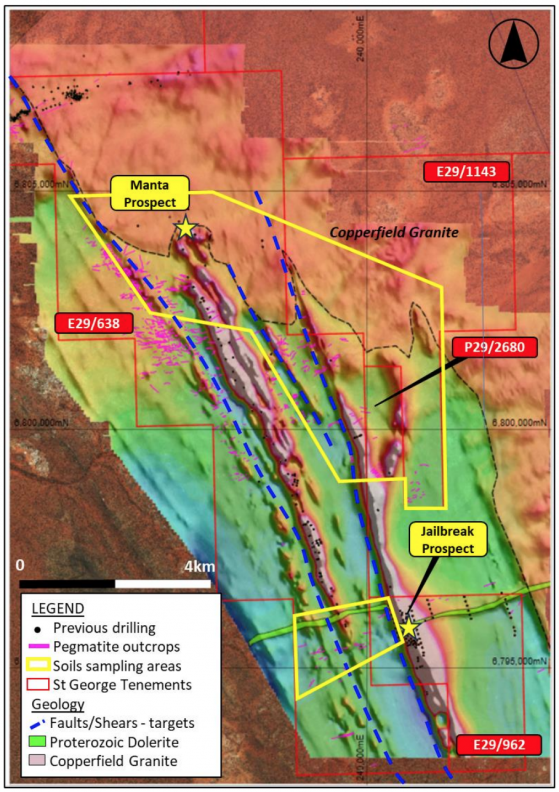St George Mining Ltd (ASX:SGQ) has identified multiple new, large-scale lithium soil anomalies at its flagship Mt Alexander Project in Western Australia.
The promising results from a geochemical soil sampling program completed in Q4 of 2024 over two broad areas at Mt Alexander include a lithium soil anomaly with a strike of more than 2.7 kilometres.
This soil survey followed drilling in late 2022 and early 2023 at the Jailbreak Prospect that confirmed the presence of lithium-mineralised pegmatites at or near the surface and up to depths of 300 metres below the surface.
High grades of up to 1.8% lithium oxide were returned in the drill results, highlighting the potential of the pegmatite system.
The soil survey also included areas on tenements acquired by St George in late 2022 and the company believes this is the first-ever systematic exploration for lithium at these tenements.
There were 1,421 soil samples collected with the survey completed on a minimum spacing of 200 metres by 100 metres.
Mt Alexander Project showing soil survey areas.
One of the new soil anomalies, which measures 1.7 kilometres by 1.3 kilometres, is along strike from the Manta Prospect, where St George intersected a 121-metre-thick fractionated pegmatite.
Another high-priority soil anomaly is along the contact of the Copperfield Granite with the Mt Alexander greenstone belt – a favourable geological setting for potential lithium mineralisation and a direct analogue to the major lithium discovery by Delta Lithium at its 14.6 million tonnes at 1.2% lithium oxide Mt Ida Project, less than 300 metres from the contact with the Copperfield Granite.
Significantly, all lithium soil anomalies have an association with elevated values for lithium pathfinder elements – particularly tantalum and caesium. This further supports the presence of an LCT (lithium-caesium-tantalum) pegmatite field that is prospective for lithium mineralisation.
Another significant outcome from the recent soil survey is the relative strength of the latest soil anomalies when compared to those of known mineralised pegmatites at Jailbreak, with the new targets showing much higher LCT anomalism.
“Disciplined and well-funded approach”
St George Mining executive chairman John Prineas said: “We are very pleased with the results of the latest soils program, which delineated not just one but a series of strong kilometre-long lithium soil anomalies in areas not yet drill tested for lithium.
“The consistency and cohesiveness of the lithium values within these large-scale anomalies is impressive. The coincident pathfinder elements like tantalum and caesium as well as the extensive pegmatite outcrop make these areas compelling drill targets.
“Drilling approvals are in place and we look forward to testing these promising targets very soon.
"The lithium exploration program at Mt Alexander is part of St George's disciplined and well-funded approach to advancing our portfolio of high-quality projects through the commodity cycle and positioning our assets for the resurgence in battery metals market conditions."
Drilling next month
The results of this soil survey emphasise the significant lithium prospectivity on the Mt Alexander landholding. St George says that with only a fraction of the large project tenure tested by drilling to date, the new soil anomalies represent compelling targets for potential new discoveries.
Extensions and in-filling to the current soil surveys are already planned to further delineate and add to the company’s current lithium target inventory. Drilling at the new soil anomaly targets – where no previous drilling has occurred – is scheduled for next month.
St George has engaged prominent mining consultancy firm, ERM (formerly known as CSA Global), to assist in lithium targeting at Mt Alexander.
A site visit by ERM and St George is underway this week, aiming to produce more high-priority targets for drilling next month.
Read more on Proactive Investors AU
